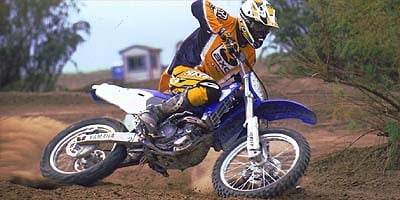Year 2001 Yamaha YZ426F - Motorcycle.com
Torrance, California, October 27, 2000 -- Honda may pride themselves on being the "the world's acknowledged four-stroke technology leader," but it's Yamaha that has produced the world's first production motorcycle with titanium valves.
The YZ426F (and its soon-to-be-released counterpart, the YZ250F) will feature Ti valves in place of the previous steel items. The reason? Lighter weight equals less reciprocating mass which equals quicker revving and higher rev ceilings that culminate in mo' power.
A few grams off of a valve (of which there are five in Yamaha'
That's not to say that steel valves don't still have a place in this cruel and unusual world we live in. It's just that -- where performance is concerned -- using Ti valves has long been a staple of performance tuners in almost every form of internal combustion. And when you're trying to extract maximum output from a given displacement (as with this single cylinder motor confined by the AMA's rules of competition), every little bit helps.
In addition to motor mods, a few changes were made to the transmission to help contain the power and ensure longevity. The suspension has also received a bit of an overhaul with the goal being reduced weight and smoother action throughout the stroke.
YZ426F gets
After spending some time on this bike at a few tracks recently, it's safe to say that, as good as last year's bike was, the new 426 is even better -- sometimes.
Ridden back-to-back with last year's bike (even the new old bike we sampled) the titanium valves -- among other things -- do make a difference. The first thing you notice upon start-up is that the new bike sounds much snappier, like it revs more freely than before.
Out onBottom-end power on this YZ is superior to that of a 250cc two-stroke, and it only gets better from there. The bike snaps into a healthy midrange before pulling into a rev-limiter that cuts in just before every living creature within a five mile radius has a heart attack. This motor absolutely wails and nobody will mistake it for a Honda XR600, or even a KTM 400SX.
When traction is plentiful, the newfound snap is a big plus. This is especially true on more Supercross-inspired tracks where instant throttle response and bark out of corners are what ensure that you land safely on the other side of the triple jump. On a slippery hard-packed surface where things are more prone to slipping and sliding around, last year's more mellow power delivery -- however slight it may be -- feels easier to manage.
The new carb' settings also make the 426F easier to bring to life. Once you learn the proper procedure (prime the cylinder, then bring piston to just after top-dead-center before giving a healthy push through the stroke) the bike starts first kick, cold or hot, thanks to the hot-start knob on the carburetor.
The only time we had a problem starting the bike is when we ran out of gas on the back side of the track and had to bum some 100 octane race gas from somebody to get back to our pits. It was here that we learned of the 426F's dislike for race gas. It was much happier running 92 octane pump gas.
That same suspension that supplied the plush ride through the chop also did a remarkable job of keeping things from getting out of sorts on hard landings. Where last year's forks would occasionally produce a metal-to-metal clunk when bottoming, the new forks never emitted such sounds even when we overjumped or came up short on the various obstacles.
We ran the bike with 98mm of sag in the rear and never had to fiddle with the clickers. As delivered, the suspension settings are surprisingly good for a number of riders. When we did break out the tools, we were able to make things work better still, but only slightly. The stock suspension is that good.
A broad powerband and predictable handling allow viscous berm-surfing.So, if you have an "old" Year 2000 YZ426F, should you run out to replace your old steel-valver with something a bit more modern, blessed with titanium valves? Not quite.
There is a noticeable difference between the two bikes when they're ridden hard. But as the case often is, it's the rider that's going to make the difference. It's just that now the rider has an even more capable tool at his (or her) disposal. It appears that the best four-stroke moto weapon on the market has just gotten better.
More by MO Staff


































Comments
Join the conversation